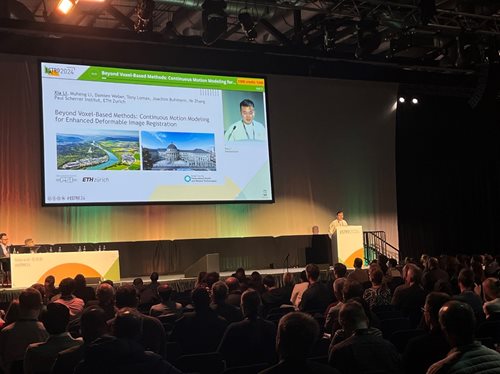ESTRO 2024 Congress report
Motivation: This study was initiated to address the limitations of voxel-based deformable image registration (DIR) methods, particularly their challenges in handling large deformations and sliding boundaries. Traditional methods often struggle with accuracy and efficiency, and these issues necessitate the development of a novel approach that uses continuous motion modelling. By leveraging implicit neural representation and large deformation diffeomorphic metric mapping (LDDMM), we aim to achieve higher precision in intra-fraction motion estimation, which ultimately will improve 4D radiotherapy treatment precision.
Most Important Finding: Our continuous motion modelling methods showed significant enhancements over traditional B-splines. Key results were:
- landmark target registration error: reduced to 0.99 ± 1.11mm for end-to-end (E2E) and 0.99 ± 1.07mm for LDD, compared to 2.79 ± 1.88mm for B-splines;
- mean absolute error (MAE) for whole-body: improved to 29.80 ± 34.09HU for E2E and 28.99 ± 32.70HU for LDD, versus 35.46 ± 46.99HU for B-splines;
- ribcage MAE and dice coefficient: without registration, the ribcage MAE was 75.40 ± 86.70HU and the dice coefficient was 89.30%. B-splines improved these to 65.65 ± 68.45HU and 90.41%, while our methods further reduced MAE to 43.62 ± 39.56HU (E2E) and 42.04 ± 39.73HU (LDD), with dice coefficients reaching 90.34% and 90.56% respectively.
Additionally, our models exhibited significantly faster processing times. B-splines required 65.34 ± 35.43 seconds, whereas our E2E and LDD methods processed in 11.96 ± 1.68 seconds and 14.32 ± 2.34 seconds respectively.
Conclusion: The continuous motion modelling approach has the potential to revolutionise DIR in radiotherapy by providing more accurate and efficient registration. This method can handle reverse trajectories and large deformations, and therefore its use reduces processing times and improves overall treatment accuracy. These advances are particularly beneficial for complex cases that involve significant anatomical changes, as they enhance patient outcomes through more precise treatment planning and delivery. Future research will explore the application of continuous motion modelling in different radiotherapy applications, including dose accumulation for adaptive treatment and image generation for upright radiotherapy.
Acknowledgements: This project is supported by the interdisciplinary doctoral grant (iDoc 2021-360) from the Personalized Health and Related Technologies of the ETH domain, Switzerland. For more detailed information, please visit our project page.

Presentation of the study at ESTRO 2024

Xia Li
Doctoral student
Paul Scherrer Institute
Villigen, Aargau, Switzerland
Email: xia.li@psi.ch